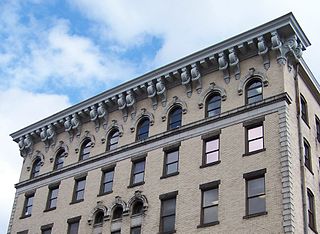
The Michigan Theatre at 124 North Mechanic Street in Jackson, Michigan opened in 1930 and was designed by Maurice Herman Finkel. It was listed on the National Register of Historic Places on May 8, 1980, and is undergoing renovations as of 2005.

The Philtower Building is a historic building located at 427 South Boston Avenue in Tulsa, Oklahoma.

The Livestock Exchange Building in Omaha, Nebraska was built in 1926 at 4920 South 30 Street in South Omaha. It was designed as the centerpiece of the Union Stockyards by architect George Prinz and built by Peter Kiewit and Sons in the Romanesque revival and Northern Italian Renaissance Revival styles. In 1999 it was designated an Omaha Landmark and listed on the National Register of Historic Places. The Union Stockyards were closed in 1999, and the Livestock Exchange Building underwent an extensive renovation over the next several years.

The Ransley Apartment Building is a historic apartment building in the Walnut Hills neighborhood of Cincinnati, Ohio, United States. Built in the 1890s, it was designed by one of Cincinnati's most important architects, and it has been named a historic site.

The Farmers' and Exchange Bank is a historic commercial building at 141 East Bay Street in Charleston, South Carolina. Built in 1853–54, it is an architecturally distinctive building, with Moorish Revival features rarely seen in the United States. The building is recognizable for its use of muqarnas—characteristic of Persian and North African architecture—as well as its large arched windows and striking red sandstone facade. It was declared a National Historic Landmark in 1973.

Board of Trade Building is a historic building in Downtown Los Angeles that was opened in 1929. Located at the northwest corner of Main Street and Seventh Street, the building was designed by Claud Beelman and Alexander Curlett in the Beaux Arts style with Classical Revival influence. The building was listed in the National Register of Historic Places in 2008 and is one of more than ten Claud Beelman buildings included in the National Register.

The Detroit–Columbia Central Office Building is a building located at 52 Selden Street in Midtown Detroit, Michigan. It is also known as the Michigan Bell Telephone Exchange. The building was listed on the National Register of Historic Places in 1997.
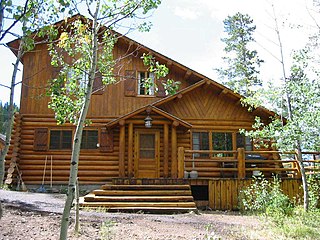
The Brinkerhoff is an historic lodge in Grand Teton National Park on the shore of Jackson Lake. It is the last remaining example of a forest lease vacation lodge in the park. The log house and caretaker's lodge were designed by architect Jan Wilking of Casper, Wyoming and were built in 1946 in what was then U.S. Forest Service land for the Brinkerhoff family. After the creation of Grand Teton National Park, the National Park Service acquired the property and used it for VIP housing. Among the guests at the Brinkerhoff were John F. Kennedy and Richard M. Nixon. The lodge is also notable as a post-war adaptation of the rustic style of architecture. The interior is an intact example of this transitional style.

The Telephone Exchange Building is a historic building at 23 Union Street in downtown Norwich, Connecticut, behind Norwich Town Hall. Built in 1906-07, it was the first purpose-built telephone exchange building in the city, and is a little-altered example of period exchanges built by the Southern New England Telephone Company. The building now houses city offices. It was listed on the National Register of Historic Places on November 28, 1983.

Central Office Building is a historic building located in downtown Davenport, Iowa, United States. It has been listed on the National Register of Historic Places since 1983. It is located in the center of a block with other historic structures. It now houses loft apartments.
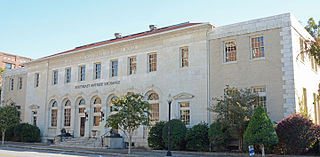
The former U.S. Post Office and Courthouse in Waycross, Georgia was built in 1911 and expanded in 1936. It is occupied in 2016 by the Southeast Antique Exchange business. The building reflects Renaissance architecture and "Romano-Tuscan" architecture. It served historically as a courthouse of the United States District Court for the Southern District of Georgia and as a post office until 1975.

The Jastro Building, also known as the Standard Oil Building, is a historic office building in Bakersfield, California. The structure was placed on the National Register of Historic Places (NRHP) on September 22, 1983.

The Buckingham Building is a 27-story skyscraper located at 59-67 E. Van Buren St. in the Loop neighborhood of Chicago, Illinois. The building, which opened in 1930, has historically served as a mixed-use retail and office building. Chicago architects Holabird and Root designed the building in the Art Deco style. It was added to the National Register of Historic Places on August 10, 2000.
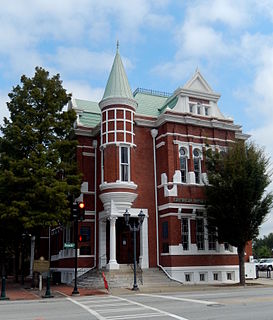
Augusta Cotton Exchange Building is a historic building in Augusta, Georgia. It was designed by Enoch William Brown and built in the mid-1880s during a cotton boom. The structure includes ornate details and ironwork and is considered High Victorian architecture. Materials for its construction were supplied locally by Charles F. Lombard's foundry. It was added to the National Register of Historic Places on July 20, 1978. It is located on Reynolds Street.

The LaSalle City Building is the historic civic hall building in LaSalle, Illinois, United States. Completed in 1907, the hall exemplifies early 20th-century trends in city management.

The Decatur station, also known as the Wabash Railroad Station and Railway Express Agency, is a historic railway station located at 780 East Cerro Gordo Street in Decatur, Illinois. Built in 1901, the station served trains on the Wabash Railroad, the most economically significant railroad through Decatur. Architect Theodore Link designed the Classical Revival building. Service to the station ended in the 1980s, and it has since been listed on the National Register of Historic Places.
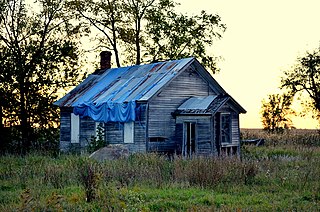
Wilson District No. 7 School, also known as the O'Meara Schoolhouse, is an historic structure located in rural Clinton County, Iowa, United States near the town of Delmar. The one-room school was listed on the National Register of Historic Places in 2004. The listing includes three structures: the former school building and two outhouses.

The Merrero Building is a historic building located in Maquoketa, Iowa, United States. It was built in 1918 to replace a three-story brick building on the same location that was damaged in a fire the previous year. While there was a debate about whether to rebuild or build new, it appears they built a new building. It is a two-story structure with three storefronts on the main level. It is significant as an example of early 20th-century commercial design and material. The exterior is composed of white glazed brick with paired windows on the second floor. An old fashioned Italianate metal cornice caps the main facade. While it looks out of place, historic photos show that it is part of the original design. Marble panels were originally located below the display windows on the main floor. The storefront on the left has been altered, but the other two are originals. Transoms above the second floor windows, and the prism glass transoms above the storefronts remain in place, but have been covered. The building was listed on the National Register of Historic Places in 1991.

The Budde–Singer Building is a historic building located in Mount Pleasant, Iowa, United States. This three story, brick Italianate structure was built in 1882. It replaced a similar building that had been built in 1856 and destroyed in a fire. Its early Italianate style is unusual for this time period, but it fits into its streetscape with similarly designed buildings, including the neighboring Brazelton House Hotel. The Budde–Singer Building features round arched windows with brick patterned hoodmolds on the second and third floors, and a bracketed wooden cornice. The first floor storefront has been somewhat altered, and the exterior of the building has been painted since about 1909. It was listed on the National Register of Historic Places in 1991.

The Continental Oil Company Filling Station at 35 First Ave. N. in Kalispell, Montana was a historic filling station built around 1932 which was listed on the National Register of Historic Places in 1994. It has since been demolished.



